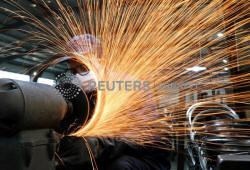China's highest producer inflation in over 12 years highlights global
price pressures
 Send a link to a friend
Send a link to a friend
 [June 09, 2021] BEIJING
(Reuters) - China's May factory gate prices rose at their fastest annual
pace in over 12 years due to surging commodity prices, highlighting
global inflation pressures at a time when policymakers are trying to
revitalise COVID-hit growth. [June 09, 2021] BEIJING
(Reuters) - China's May factory gate prices rose at their fastest annual
pace in over 12 years due to surging commodity prices, highlighting
global inflation pressures at a time when policymakers are trying to
revitalise COVID-hit growth.
Investors are increasingly worried pandemic-driven stimulus measures
could supercharge global inflation and force central banks to tighten
policy, potentially curbing the recovery.
China's producer price index (PPI) increased 9.0%, the National Bureau
of Statistics (NBS) said on Wednesday, as prices bounced back from last
year's pandemic lows.
The PPI rise in May - the fastest on-year gain for any month since
September 2008 - was driven by significant price increases in crude oil,
iron ore and non-ferrous metals, the NBS said.
Analysts in a Reuters poll had expected the PPI to rise 8.5% after a
6.8% increase in April.

Shortly after the inflation data, the National Development and Reform
Commission said China will closely monitor price movements of
commodities and step up price forecasts to maintain market order.
"The worry is PPI may hover at an elevated level for an extended period
of time, which would create economic headaches if mid- or downstream
firms fail to absorb higher costs," said Nie Wen, chief economist at
Hwabao Trust.
The PPI surge has yet to substantially feed through to consumer
inflation, meaning the People's Bank of China is unlikely to worry for
now.
Consumer prices rose 1.3% in May - the biggest year-on-year increase in
eight months - but came in below expectations for a 1.6% gain. Consumer
inflation remained well below the government's official target of around
3%.
"Producer price inflation is probably close to a peak...we don't expect
(consumer price inflation) to rise much above 2% in the coming quarters.
As such, (the data) is unlikely to trigger any shift in monetary
policy," said Julian Evans-Pritchard, senior China economist at Capital
Economics.
But there are some signs Chinese factories, facing already tight
margins, are passing on higher raw material costs to overseas clients,
which could reinforce the global inflation loop.
(Graphic: China factory gate prices surge at fastest pace in 12 years as
commodity costs climb:
https://fingfx.thomsonreuters.com/
gfx/ce/rlgvddxyovo/
ChinaFactoryGatePrices.png)
The release comes as U.S. inflation data on Thursday is being closely
watched by investors, who worry another high reading might put pressure
on the Federal Reserve to start thinking about tapering its stimulus.
[to top of second column] |

A worker wearing a face mask works on a production line
manufacturing bicycle steel rim at a factory, as the country is hit
by the novel coronavirus outbreak, in Hangzhou, Zhejiang province,
China March 2, 2020. China Daily via REUTERS/File Photo

Chinese coal and resource shares rose after the NBS's producer price inflation
data, driving the broader stock market higher. [L2N2NR08S]
COMMODITY PRICES
On a monthly basis, the PPI rose 1.6%, up from a 0.9% uptick in April.
Power plants also stocked up on thermal coal to meet surging electricity demand
during summer, resulting in a 10.6% month-on-month increase in prices in the
coal mining and washing sector, up from 2.8% the previous month, said Dong
Lijuan, senior statistician at the NBS.
Prices for commodities including coal, steel, iron ore and copper, which affect
the PPI, have surged this year, fuelled by post-lockdown recoveries in demand
and ample global liquidity.
China's imports in value terms grew at their fastest pace in 10 years in May,
boosted by Chinese purchases of raw materials.
Chinese policymakers have pledged to take measures to cool commodity prices and
prevent them from being passed on to consumers.
Recent gains in the yuan had stirred speculation over whether policymakers
wanted a stronger currency to offset growing imported price pressures, but the
central bank told Reuters this week it will not use the exchange rate as a tool.
NBS data also showed food inflation rose 0.3% in May from a year earlier on
higher prices for freshwater fish and eggs, despite still falling pork prices.
That compared with a 0.7% drop in food prices in April.

Non-food prices, including airfares, gasoline and diesel prices, accelerated to
5.5%, likely bolstered by China's Labour Day Holiday at the start of May.
On a monthly basis, rising factory input costs have started to be passed onto
consumers in the sales of fridges, televisions, laptops, construction materials
and summer clothes, but their price gains remained mild, NBS's Dong said.
(Reporting by Liangping Gao, Stella Qiu and Ryan Woo; Editing by Ana Nicolaci da
Costa
[© 2021 Thomson Reuters. All rights
reserved.] Copyright 2021 Reuters. All rights reserved. This material may not be published,
broadcast, rewritten or redistributed.
Thompson Reuters is solely responsible for this content. |